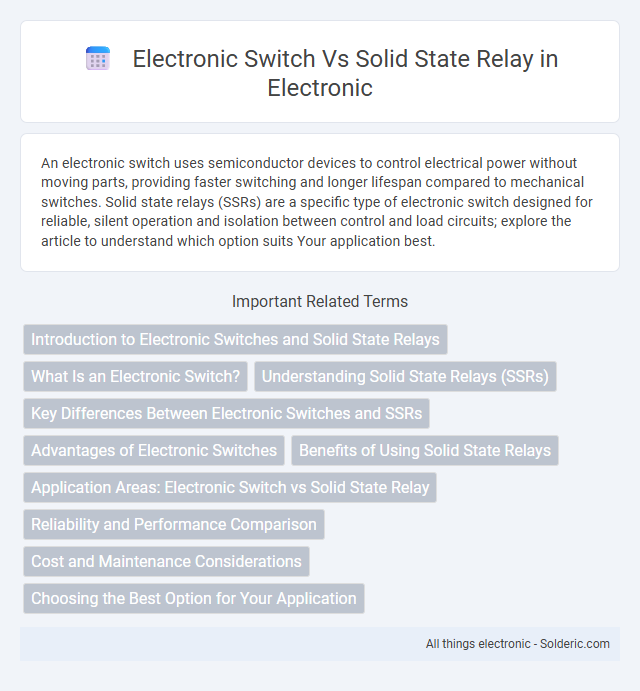An electronic switch uses semiconductor devices to control electrical power without moving parts, providing faster switching and longer lifespan compared to mechanical switches. Solid state relays (SSRs) are a specific type of electronic switch designed for reliable, silent operation and isolation between control and load circuits; explore the article to understand which option suits Your application best.
Comparison Table
| Feature | Electronic Switch | Solid State Relay (SSR) |
|---|---|---|
| Definition | Device that controls electric current flow electronically. | Semiconductor-based relay for switching AC/DC loads without moving parts. |
| Switching Speed | Fast, typically in microseconds to milliseconds. | Fast, generally in milliseconds. |
| Mechanical Parts | No mechanical parts, purely electronic. | No mechanical parts, solid-state design. |
| Durability | High durability due to no wear and tear. | High durability, long operational life. |
| Isolation | Usually requires external isolation components. | Provides electrical isolation between input and output. |
| Load Handling | Typically low to moderate current and voltage. | Capable of switching high current and voltage loads. |
| Applications | Signal switching, low power electronics. | Industrial control, motor control, heating elements. |
| Cost | Generally lower cost for simple switching. | Higher cost due to integrated isolation and ruggedness. |
| Power Consumption | Low power consumption in control circuit. | Low control power; some heat dissipation on load side. |
Introduction to Electronic Switches and Solid State Relays
Electronic switches control the flow of electrical current by opening or closing circuits through semiconductor devices like transistors or thyristors, offering fast switching times and high reliability. Solid State Relays (SSRs) are a specific type of electronic switch that use optocouplers to isolate control signals from the load, providing silent operation and longer lifespan compared to mechanical relays. Your choice between electronic switches and SSRs depends on factors such as switching speed, isolation requirements, and load type.
What Is an Electronic Switch?
An electronic switch is a device that controls the flow of electrical current by using a low-power signal to turn on or off a high-power circuit without mechanical movement. It typically uses semiconductor components such as transistors, MOSFETs, or thyristors to achieve fast switching speeds and high reliability. Unlike solid state relays, which integrate optocouplers for isolation, electronic switches may or may not provide galvanic isolation depending on their design and application requirements.
Understanding Solid State Relays (SSRs)
Solid State Relays (SSRs) are electronic switches that control electrical power without moving parts, using semiconductor components like thyristors or triacs to switch circuits on and off. These devices offer faster switching speeds, longer lifespan, and enhanced reliability compared to traditional mechanical relays by eliminating physical contacts that wear out over time. Your system benefits from SSRs through reduced electrical noise, zero-contact bounce, and improved performance in applications requiring frequent or high-speed switching.
Key Differences Between Electronic Switches and SSRs
Electronic switches use transistors or MOSFETs to control current flow with fast switching speeds and low power consumption, making them ideal for low-voltage applications. Solid state relays (SSRs) provide galvanic isolation and handle higher voltages and currents by using optocouplers and TRIACs or thyristors, suited for industrial and AC load control. Your choice depends on switching speed, voltage requirements, and the need for electrical isolation in your application.
Advantages of Electronic Switches
Electronic switches offer rapid switching speeds and high reliability due to their lack of mechanical parts, enabling efficient control in high-frequency applications. They consume less power and generate minimal heat compared to solid state relays, enhancing energy efficiency and system longevity. Their compact size and precise control capabilities make electronic switches ideal for integration in complex circuits and automated systems.
Benefits of Using Solid State Relays
Solid state relays offer significant benefits over traditional electronic switches, including faster switching speeds, longer operational life due to the absence of mechanical parts, and enhanced reliability in harsh environments. Their compact design reduces space requirements while providing noise-free operation and minimal electromagnetic interference, making them ideal for sensitive electronic applications. You can achieve greater system efficiency and durability by integrating solid state relays into your control systems.
Application Areas: Electronic Switch vs Solid State Relay
Electronic switches are widely used in consumer electronics, automotive systems, and communication devices for controlling low to moderate power loads with fast switching speeds. Solid state relays (SSRs) are preferred in industrial automation, HVAC systems, and medical equipment due to their durability, reliability, and ability to handle high voltage and current without mechanical wear. SSRs also provide silent operation and enhanced resistance to shock and vibration, making them suitable for harsh environments where traditional electronic switches might fail.
Reliability and Performance Comparison
Electronic switches offer high switching speeds and low power consumption but are susceptible to wear and contact degradation over time, impacting long-term reliability. Solid state relays (SSRs) provide superior reliability with no mechanical parts, resulting in longer lifespan and consistent performance under high electrical loads and frequent switching cycles. SSRs also minimize electromagnetic interference and switching noise, enhancing overall system stability compared to traditional electronic switches.
Cost and Maintenance Considerations
Electronic switches generally offer lower initial costs than solid state relays (SSRs), making them more budget-friendly for simple applications. You may face higher maintenance requirements with electronic switches due to mechanical wear and tear, whereas SSRs have no moving parts, resulting in minimal maintenance. Over time, the durability and reliability of SSRs can reduce total operational costs compared to traditional electronic switches.
Choosing the Best Option for Your Application
Electronic switches offer fast response times and precise control, making them ideal for applications requiring rapid switching and minimal signal distortion. Solid state relays provide superior durability and isolation, excelling in environments with high electrical noise or where mechanical wear is a concern. Evaluate factors such as switching speed, electrical isolation, load type, and environmental conditions to choose between electronic switches and solid state relays for optimal performance.
electronic switch vs solid state relay Infographic

 solderic.com
solderic.com